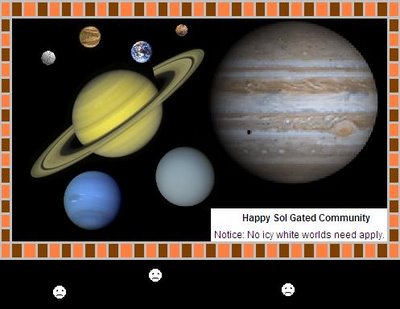Planetary Exclusivity: Evicting Pluto

On August 24th, 2006, after many years of hard effort, a small self-serving voting group of the International Astronomical Union (IAU) has officially excluded Pluto from the list of official planets of our solar system with a bit of definitive legerdemain. As a consequence, tens of millions -- if not billions -- of publications and video programs will need to have errata added to them to inform confused school children and adults around the world that there are no longer 9 official planets, but just 8 -- with a generous helping of asteroids, TNOs and KBOs tossed in the mix.
A child or adult might even make the forgivable mistake of assuming that the IAU had actually destroyed Pluto -- reducing it into a handful of TNOs and KBOs -- with some kind of planet-killing device (perhaps an Eludium PU36 Explosive Space Modulator). This would undoubtedly give the child or adult the distinct impression that the IAU is as dark, as sinister, and as powerful an organization as the Illuminati -- which they may yet turn out to be.
Is there any value in the IAU's new definition of planets? Yes, somewhat. It attempts to put a ceiling on the number of "classic planets" that our solar system contains (eight -- no more, no less). These planets are divided into the four inner "rocky" planets: Mercury, Venus, Earth, and Mars (I don't use the term terrestrial due to my issues with "earthlike" exo-planets presented in a previous blog entry) and the four outer gas-giant planets: Jupiter, Saturn, Uranus, and Neptune. It also guarantees that there is no way someone will discover any new planets, per se. Any new discovery will most like fall into one of two buckets of lesser solar system bodies "dwarf planets" or other (asteroids and comets). Dwarf planets include some of the bigger TNOs (which include Pluto), KBOs, and the asteroid Ceres. Basically it's the catch all for everything outside of the "big 8". The exact text of the official resolution the IAU passed was as follows:
RESOLUTION 5A
The IAU therefore resolves that "planets" and other bodies in our Solar System, except satellites, be defined into three distinct categories in the following way:
(1) A "planet"1 is a celestial body that (a) is in orbit around the Sun, (b) has sufficient mass for its self-gravity to overcome rigid body forces so that it assumes a hydrostatic equilibrium (nearly round) shape, and (c) has cleared the neighbourhood around its orbit.
(2) A "dwarf planet" is a celestial body that (a) is in orbit around the Sun, (b) has sufficient mass for its self-gravity to overcome rigid body forces so that it assumes a hydrostatic equilibrium (nearly round) shape2 , (c) has not cleared the neighbourhood around its orbit, and (d) is not a satellite.
(3) All other objects3 except satellites orbiting the Sun shall be referred to collectively as "Small Solar-System Bodies".
1The eight "planets" are: Mercury, Venus, Earth, Mars, Jupiter, Saturn, Uranus, and Neptune.
2An IAU process will be established to assign borderline objects into either dwarf planet and other categories.
3These currently include most of the Solar System asteroids, most Trans-Neptunian Objects (TNOs), comets, and other small bodies.
There are a few issues with this resolution that are somewhat ambiguous. As has been noted by other people, looking at items #1c and #2c in the resolution, jupiter -- with it's trojan asteroids -- and Neptune -- with it's Trans Neptunian Objects -- are dwarf planets by this definition. Clearly that doesn't make much sense.
An alternative might be something along these lines: A "planet" is a celestial body that (a) is in orbit around the Sun, (b) has sufficient mass for its self-gravity to overcome rigid body forces so that it assumes a hydrostatic equilibrium (nearly round) shape, (c) is not a moon of a bigger planet, and (d) is bigger than 1000km in diameter. This definition would include Pluto and a few other TNOs and KBOs as planets, and would validate Jupiter and Neptune as classic planets. Our solar system would end up with 9 planets and the room to include a few more objects as planets -- undoubtedly inspiring the careers of some future astronomers.
Conclusion
I admit that Pluto and its kin are a bit more difficult to classify than the other 8 planets. And since it does cross the orbit of Neptune, it is at the very least unique. (NOTE, however, that it's orbital eccentricity really isn't all that much greater that the planet Mercury.) In my mind, Pluto and it kin are a third class of planetary objects. They represent a group that might be called ice planets. Therefore our solar system would consist of rocky planets, gas giants, and ice planets. This seems to be a worthwhile distinction. It's worthwhile to also consider where these ice planets exist in the scheme of solar system formation. It's pretty clear that the rocky planets and gas giants coalesced out of the original solar disk. But the ice planets are so numerous and spread out that it isn't clear to me that they have managed this feat. As a result, it seems to me that some of them may represent objects that existed before the formation of our solar system.
Are they "real" planets. I don't know, and I can certainly see why others would care to eliminate them from the club. Still, it seems a bit like putting up a gated community in the solar system.

